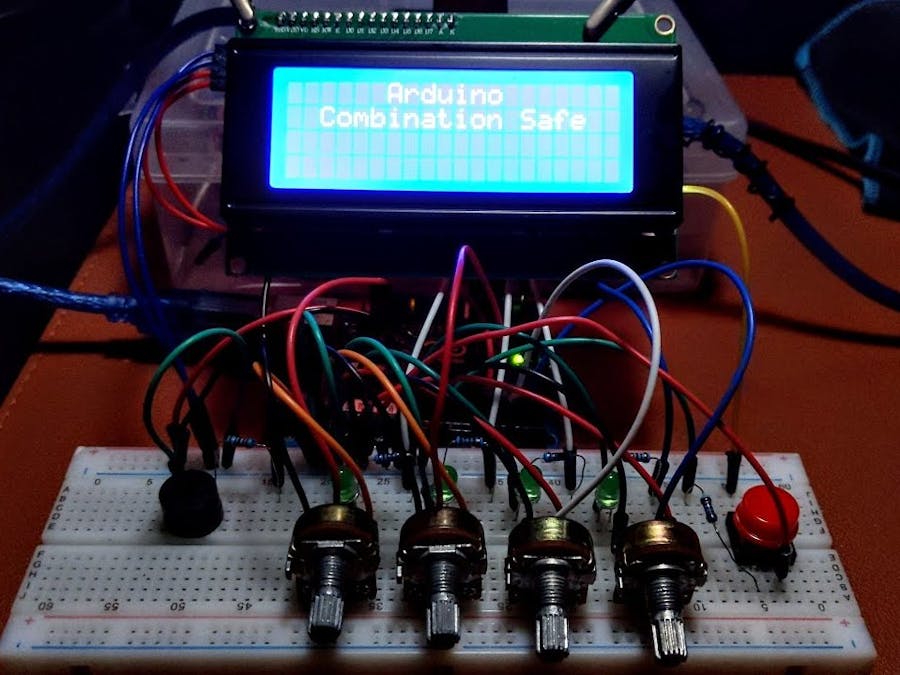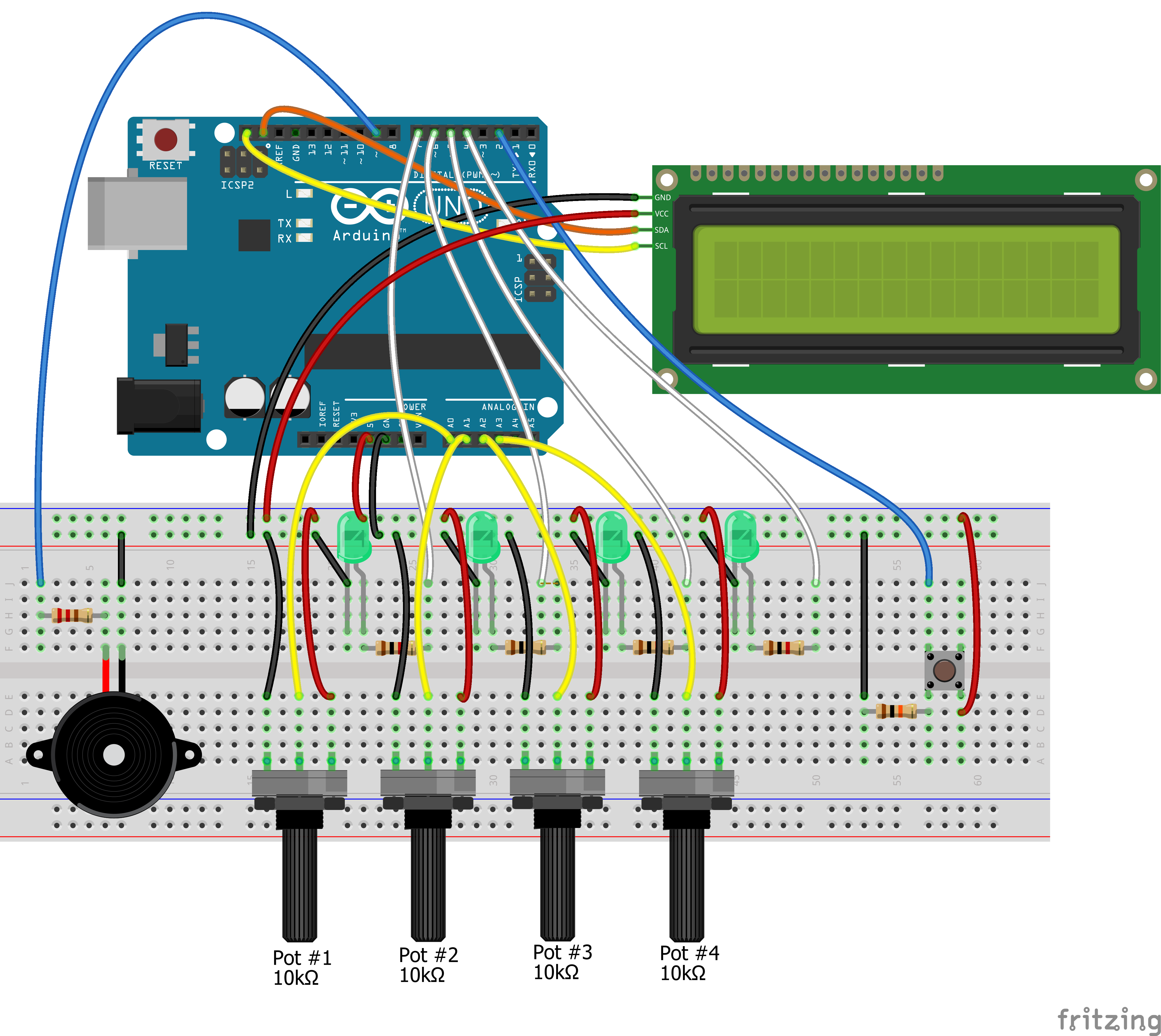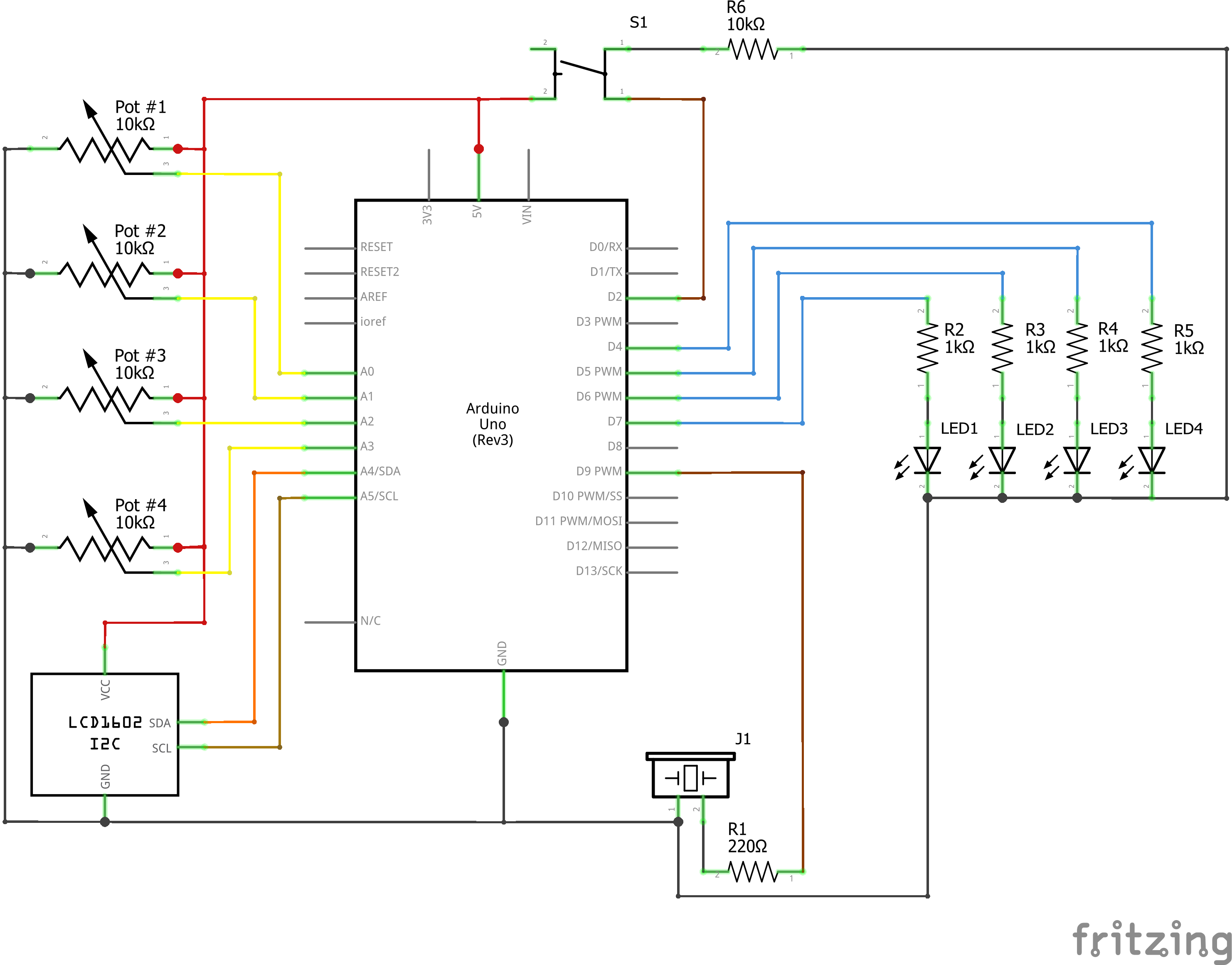/* Arduino 'Combination Safe' concept
Components:
- Arduino Uno
- Green LED (x 4)
- 10KOhm potentiometer (x 4)
- 1kOhm resistor (x 4)
- 220Ohm resistor
- LCD I2C (20x4)
- Passive Buzzer
- Push button tactile switch
- Some jumper wires
Libraries:
- LiquidCrystal_I2C library
Created on 29 June 2022 by c010rblind3ngineer
*/
#include <LiquidCrystal_I2C.h>
int pot1, pot2, pot3, pot4;
const int buzzer = 9;
const int buttonPin = 2;
////////////////////////////////////////////////////////////////////////////////
// LEDs are for visual indication of the correct input password, //
// for future project you could put numeric indicators on each potentiometer. //
////////////////////////////////////////////////////////////////////////////////
const int D1_LED = 7;
const int D2_LED = 6;
const int D3_LED = 5;
const int D4_LED = 4;
unsigned long firstDigitTime;
unsigned long lastDigitTime;
int timeLimit = 8000; // time limit for User to input combination
int i = 0;
int t = 0;
int load = 0;
int line;
int count;
int password[5] = {1, 2, 3, 4}; // set your own password here...
byte loadingBar[] = {
B11111,
B11111,
B11111,
B11111,
B11111,
B11111,
B11111,
B11111,
};
LiquidCrystal_I2C lcd(0x27, 20, 4);
void setup() {
Serial.begin(9600);
pinMode(D1_LED, OUTPUT);
pinMode(D2_LED, OUTPUT);
pinMode(D3_LED, OUTPUT);
pinMode(D4_LED, OUTPUT);
pinMode(buttonPin, INPUT);
lcd.init();
lcd.createChar(0, loadingBar);
}
void loop() {
//////////////////////////////////////////////////////////////
// There are 3 sets of 'Combination' functions: //
// Combination_original() ---->> pot#1, pot#2, pot#3, pot#4 //
// Combination_one() ---->> pot#1, pot#3, pot#2, pot#4 //
// Combination_two() ---->> pot#4, pot#3, pot#2, pot#1 //
//////////////////////////////////////////////////////////////
for (count = 0; count < 3;) {
if (count == 0) {
while (load < 1) {
safeInit();
load = 1;
}
Combination_original();
}
if (count == 1) {
while (load < 1) {
lcd.clear();
lcd.print("Press button once...");
while (digitalRead(buttonPin) != HIGH) {}
if (digitalRead(buttonPin) == HIGH) {
i = 0;
t = 0;
}
delay(100);
safeInit();
load = 1;
}
Combination_one();
}
if (count == 2) {
while (load < 1) {
lcd.clear();
lcd.print("Press button once...");
while (digitalRead(buttonPin) != HIGH) {}
if (digitalRead(buttonPin) == HIGH) {
i = 0;
t = 0;
}
delay(100);
safeInit();
load = 1;
}
Combination_two();
}
}
// if User fail to input combination within time limit for ALL tries, shutdown system...
delay(3000);
lcd.clear();
lcd.setCursor(0, 1);
lcd.print(" Goodbye. ");
delay(1000);
tone(buzzer, 2000);
delay(100);
noTone(buzzer);
delay(50);
tone(buzzer, 2000);
delay(100);
noTone(buzzer);
delay(50);
lcd.clear();
lcd.noBacklight();
}
// Initialization & Loading screen
void safeInit() {
lcd.backlight();
lcd.setCursor(0, 0);
lcd.print(" Arduino ");
lcd.setCursor(0, 1);
lcd.print(" Combination Safe ");
delay(5000);
lcd.clear();
lcd.print(" Loading... ");
delay(1000);
lcd.setCursor(0, 1);
for (line = 0; line < 20; line++) {
lcd.write(0);
delay(200);
}
delay(250);
tone(buzzer, 2000);
delay(100);
noTone(buzzer);
delay(50);
tone(buzzer, 2000);
delay(100);
noTone(buzzer);
delay(50);
lcd.clear();
lcd.setCursor(0, 1);
lcd.print(" Enter combination: ");
}
///////////////////////////Combination # Original/////////////////////////////
// Turn potentiometers in this sequence: //
// First - pot #1 //
// Second - pot #2 //
// Third - pot #3 //
// Fourth - pot #4 //
// *NOTE*: You can set your own combination sequence by changing the //
// arrangement of pot1_digact - pot4_digact in the 'if' //
// statements. //
//////////////////////////////////////////////////////////////////////////////
void Combination_original() {
while (i < 4) {
if (pot1_digact(password[0]) == 1) { // pot #1
digitalWrite(D1_LED, HIGH); // turn ON 1st LED
// capture time taken for the user to input the FIRST digit
while (t < 1) {
firstDigitTime = millis();
Serial.print("First Digit Time: ");
Serial.println(firstDigitTime);
t = 1;
}
i = 1;
if (pot2_digact(password[1]) == 1) { // pot #2
digitalWrite(D2_LED, HIGH); // turn ON 2nd LED
i = 2;
if (pot3_digact(password[2]) == 1) { // pot #3
digitalWrite(D3_LED, HIGH); // turn ON 3rd LED
i = 3;
if (pot4_digact(password[3]) == 1) { // pot #4
digitalWrite(D4_LED, HIGH); // turn ON 4th LED
t = 0; // re-enable 'timer'
// capture time taken for the user to input the LAST digit
while (t < 1) {
lastDigitTime = millis();
Serial.print("Last Digit Time: ");
Serial.println(lastDigitTime);
t = 1;
}
// Compare start and end timing if User enter password within the time limit
if (lastDigitTime - firstDigitTime < timeLimit) {
//ACCESS GRANTED HERE//
accessGranted();
}
else {
//ACCCESS DENIED HERE//
accessDenied();
count++;
load = 0;
}
delay(1000);
digitalWrite(D1_LED, LOW);
digitalWrite(D3_LED, LOW);
digitalWrite(D2_LED, LOW);
digitalWrite(D4_LED, LOW);
i = 4;
}
else {
digitalWrite(D4_LED, LOW);
}
}
else {
digitalWrite(D3_LED, LOW);
}
}
else {
digitalWrite(D2_LED, LOW);
}
}
else {
digitalWrite(D1_LED, LOW);
}
}
}
///////////////////////////Combination # ONE//////////////////////////////////
// Turn potentiometers in this sequence: //
// First - pot #1 //
// Second - pot #3 //
// Third - pot #2 //
// Fourth - pot #4 //
// *NOTE*: You can set your own combination sequence by changing the //
// arrangement of pot1_digact - pot4_digact in the 'if' //
// statements. //
//////////////////////////////////////////////////////////////////////////////
void Combination_one() {
while (i < 4) {
if (pot1_digact(password[0]) == 1) { // pot #1
digitalWrite(D1_LED, HIGH); // turn ON 1st LED
// capture time taken for the user to input the FIRST digit
while (t < 1) {
firstDigitTime = millis();
Serial.print("First Digit Time: ");
Serial.println(firstDigitTime);
t = 1;
}
i = 1;
if (pot3_digact(password[1]) == 1) { // pot #3
digitalWrite(D2_LED, HIGH); // turn ON 2nd LED
i = 2;
if (pot2_digact(password[2]) == 1) { // pot #2
digitalWrite(D3_LED, HIGH); // turn ON 3rd LED
i = 3;
if (pot4_digact(password[3]) == 1) { // pot #4
digitalWrite(D4_LED, HIGH); // turn ON 4th LED
t = 0; // re-enable 'timer'
// capture time taken for the user to input the LAST digit
while (t < 1) {
lastDigitTime = millis();
Serial.print("Last Digit Time: ");
Serial.println(lastDigitTime);
t = 1;
}
// Compare start and end timing if User enter password within the time limit
if (lastDigitTime - firstDigitTime < timeLimit) {
//ACCESS GRANTED HERE//
accessGranted();
}
else {
//ACCESS DENIED HERE//
accessDenied();
count++;
load = 0;
}
delay(1000);
digitalWrite(D1_LED, LOW);
digitalWrite(D3_LED, LOW);
digitalWrite(D2_LED, LOW);
digitalWrite(D4_LED, LOW);
i = 4;
}
else {
digitalWrite(D4_LED, LOW);
}
}
else {
digitalWrite(D3_LED, LOW);
}
}
else {
digitalWrite(D2_LED, LOW);
}
}
else {
digitalWrite(D1_LED, LOW);
}
}
}
///////////////////////////Combination # TWO//////////////////////////////////
// Turn potentiometers in this sequence: //
// First - pot #4 //
// Second - pot #3 //
// Third - pot #2 //
// Fourth - pot #1 //
// *NOTE*: You can set your own combination sequence by changing the //
// arrangement of pot1_digact - pot4_digact in the 'if' //
// statements. //
//////////////////////////////////////////////////////////////////////////////
void Combination_two() {
while (i < 4) {
if (pot4_digact(password[0]) == 1) { // pot #4
digitalWrite(D1_LED, HIGH); // turn ON 1st LED
// capture time taken for the user to input the FIRST digit
while (t < 1) {
firstDigitTime = millis();
Serial.print("First Digit Time: ");
Serial.println(firstDigitTime);
t = 1;
}
i = 1;
if (pot3_digact(password[1]) == 1) { // pot #3
digitalWrite(D2_LED, HIGH); // turn ON 2nd LED
i = 2;
if (pot2_digact(password[2]) == 1) { // pot #2
digitalWrite(D3_LED, HIGH); // turn ON 3rd LED
i = 3;
if (pot1_digact(password[3]) == 1) { // pot #1
digitalWrite(D4_LED, HIGH); // turn ON 4th LED
t = 0; // re-enable 'timer'
// capture time taken for the user to input the LAST digit
while (t < 1) {
lastDigitTime = millis();
Serial.print("Last Digit Time: ");
Serial.println(lastDigitTime);
t = 1;
}
// Compare start and end timing if User enter password within the time limit
if (lastDigitTime - firstDigitTime < timeLimit) {
//ACCESS GRANTED HERE//
accessGranted();
}
else {
//ACCESS DENIED HERE//
accessDenied();
count++;
}
delay(1000);
digitalWrite(D1_LED, LOW);
digitalWrite(D3_LED, LOW);
digitalWrite(D2_LED, LOW);
digitalWrite(D4_LED, LOW);
i = 4;
}
else {
digitalWrite(D4_LED, LOW);
}
}
else {
digitalWrite(D3_LED, LOW);
}
}
else {
digitalWrite(D2_LED, LOW);
}
}
else {
digitalWrite(D1_LED, LOW);
}
}
}
////////////////////////////////////////////////////////////////////////////
// This function turns the 1st potentiometer into a rotating dial (1 - 9) //
////////////////////////////////////////////////////////////////////////////
int pot1_digact(int val) {
pot1 = analogRead(A0);
// for 1st digit of the password
switch (val) {
case 1:
if ((val == 1) && pot1 >= 100 && pot1 <= 199) {
return 1;
}
else {
return 0;
}
break;
case 2:
if ((val == 2) && pot1 >= 200 && pot1 <= 399) {
return 1;
}
else {
return 0;
}
break;
case 3:
if ((val == 3) && pot1 >= 300 && pot1 <= 399) {
return 1;
}
else {
return 0;
}
break;
case 4:
if ((val == 4) && pot1 >= 400 && pot1 <= 499) {
return 1;
}
else {
return 0;
}
break;
case 5:
if ((val == 5) && pot1 >= 500 && pot1 <= 599) {
return 1;
}
else {
return 0;
}
break;
case 6:
if ((val == 6) && pot1 >= 600 && pot1 <= 699) {
return 1;
}
else {
return 0;
}
break;
case 7:
if ((val == 7) && pot1 >= 700 && pot1 <= 799) {
return 1;
}
else {
return 0;
}
break;
case 8:
if ((val == 8) && pot1 >= 800 && pot1 <= 899) {
return 1;
}
else {
return 0;
}
break;
case 9:
if ((val == 9) && pot1 >= 900) {
return 1;
}
else {
return 0;
}
break;
}
}
////////////////////////////////////////////////////////////////////////////
// This function turns the 2nd potentiometer into a rotating dial (1 - 9) //
////////////////////////////////////////////////////////////////////////////
int pot2_digact(int val) {
pot2 = analogRead(A1);
// for 2nd digit of the password
switch (val) {
case 1:
if ((val == 1) && pot2 >= 100 && pot2 <= 199) {
return 1;
}
else {
return 0;
}
break;
case 2:
if ((val == 2) && pot2 >= 200 && pot2 <= 399) {
return 1;
}
else {
return 0;
}
break;
case 3:
if ((val == 3) && pot2 >= 300 && pot2 <= 399) {
return 1;
}
else {
return 0;
}
break;
case 4:
if ((val == 4) && pot2 >= 400 && pot2 <= 499) {
return 1;
}
else {
return 0;
}
break;
case 5:
if ((val == 5) && pot2 >= 500 && pot2 <= 599) {
return 1;
}
else {
return 0;
}
break;
case 6:
if ((val == 6) && pot2 >= 600 && pot2 <= 699) {
return 1;
}
else {
return 0;
}
break;
case 7:
if ((val == 7) && pot2 >= 700 && pot2 <= 799) {
return 1;
}
else {
return 0;
}
break;
case 8:
if ((val == 8) && pot2 >= 800 && pot2 <= 899) {
return 1;
}
else {
return 0;
}
break;
case 9:
if ((val == 9) && pot2 >= 900) {
return 1;
}
else {
return 0;
}
break;
}
}
////////////////////////////////////////////////////////////////////////////
// This function turns the 3rd potentiometer into a rotating dial (1 - 9) //
////////////////////////////////////////////////////////////////////////////
int pot3_digact(int val) {
pot3 = analogRead(A2);
// for 3rd digit of the password
switch (val) {
case 1:
if ((val == 1) && pot3 >= 100 && pot3 <= 199) {
return 1;
}
else {
return 0;
}
break;
case 2:
if ((val == 2) && pot3 >= 200 && pot3 <= 399) {
return 1;
}
else {
return 0;
}
break;
case 3:
if ((val == 3) && pot3 >= 300 && pot3 <= 399) {
return 1;
}
else {
return 0;
}
break;
case 4:
if ((val == 4) && pot3 >= 400 && pot3 <= 499) {
return 1;
}
else {
return 0;
}
break;
case 5:
if ((val == 5) && pot3 >= 500 && pot3 <= 599) {
return 1;
}
else {
return 0;
}
break;
case 6:
if ((val == 6) && pot3 >= 600 && pot3 <= 699) {
return 1;
}
else {
return 0;
}
break;
case 7:
if ((val == 7) && pot3 >= 700 && pot3 <= 799) {
return 1;
}
else {
return 0;
}
break;
case 8:
if ((val == 8) && pot3 >= 800 && pot3 <= 899) {
return 1;
}
else {
return 0;
}
break;
case 9:
if ((val == 9) && pot3 >= 900) {
return 1;
}
else {
return 0;
}
break;
}
}
////////////////////////////////////////////////////////////////////////////
// This function turns the 4th potentiometer into a rotating dial (1 - 9) //
////////////////////////////////////////////////////////////////////////////
int pot4_digact(int val) {
pot4 = analogRead(A3);
// for 4th digit of the password
switch (val) {
case 1:
if ((val == 1) && pot4 >= 100 && pot4 <= 199) {
return 1;
}
else {
return 0;
}
break;
case 2:
if ((val == 2) && pot4 >= 200 && pot4 <= 399) {
return 1;
}
else {
return 0;
}
break;
case 3:
if ((val == 3) && pot4 >= 300 && pot4 <= 399) {
return 1;
}
else {
return 0;
}
break;
case 4:
if ((val == 4) && pot4 >= 400 && pot4 <= 499) {
return 1;
}
else {
return 0;
}
break;
case 5:
if ((val == 5) && pot4 >= 500 && pot4 <= 599) {
return 1;
}
else {
return 0;
}
break;
case 6:
if ((val == 6) && pot4 >= 600 && pot4 <= 699) {
return 1;
}
else {
return 0;
}
break;
case 7:
if ((val == 7) && pot4 >= 700 && pot4 <= 799) {
return 1;
}
else {
return 0;
}
break;
case 8:
if ((val == 8) && pot4 >= 800 && pot4 <= 899) {
return 1;
}
else {
return 0;
}
break;
case 9:
if ((val == 9) && pot4 >= 900) {
return 1;
}
else {
return 0;
}
break;
}
}
void accessGranted() {
lcd.clear();
lcd.setCursor(0, 1);
lcd.print(" Access Granted ");
digitalWrite(D1_LED, LOW);
digitalWrite(D3_LED, LOW);
digitalWrite(D2_LED, LOW);
digitalWrite(D4_LED, LOW);
tone(buzzer, 2000);
digitalWrite(D1_LED, HIGH);
digitalWrite(D3_LED, HIGH);
digitalWrite(D2_LED, HIGH);
digitalWrite(D4_LED, HIGH);
delay(100);
digitalWrite(D1_LED, LOW);
digitalWrite(D3_LED, LOW);
digitalWrite(D2_LED, LOW);
digitalWrite(D4_LED, LOW);
noTone(buzzer);
delay(100);
digitalWrite(D1_LED, HIGH);
digitalWrite(D3_LED, HIGH);
digitalWrite(D2_LED, HIGH);
digitalWrite(D4_LED, HIGH);
tone(buzzer, 2000);
delay(100);
noTone(buzzer);
delay(100);
}
void accessDenied() {
lcd.clear();
lcd.setCursor(0, 1);
lcd.print(" Access Denied ");
tone(buzzer, 1000);
delay(250);
noTone(buzzer);
delay(100);
tone(buzzer, 1000);
delay(250);
noTone(buzzer);
delay(100);
tone(buzzer, 1000);
delay(250);
noTone(buzzer);
delay(100);
lcd.clear();
lcd.setCursor(0, 0);
lcd.print(" Please reset ");
lcd.setCursor(0, 1);
lcd.print("ALL FOUR knobs to 0");
lcd.setCursor(0, 2);
for (line = 0; line < 20; line++) {
lcd.write(0);
delay(1000);
}
}
_ztBMuBhMHo.jpg?auto=compress%2Cformat&w=48&h=48&fit=fill&bg=ffffff)

















Comments